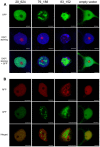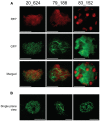Characterization of cell death inducing Phytophthora capsici CRN effectors suggests diverse activities in the host nucleus
- PMID: 24155749
- PMCID: PMC3803116
- DOI: 10.3389/fpls.2013.00387
Characterization of cell death inducing Phytophthora capsici CRN effectors suggests diverse activities in the host nucleus
Abstract
Plant-Microbe interactions are complex associations that feature recognition of Pathogen Associated Molecular Patterns by the plant immune system and dampening of subsequent responses by pathogen encoded secreted effectors. With large effector repertoires now identified in a range of sequenced microbial genomes, much attention centers on understanding their roles in immunity or disease. These studies not only allow identification of pathogen virulence factors and strategies, they also provide an important molecular toolset suited for studying immunity in plants. The Phytophthora intracellular effector repertoire encodes a large class of proteins that translocate into host cells and exclusively target the host nucleus. Recent functional studies have implicated the CRN protein family as an important class of diverse effectors that target distinct subnuclear compartments and modify host cell signaling. Here, we characterized three necrosis inducing CRNs and show that there are differences in the levels of cell death. We show that only expression of CRN20_624 has an additive effect on PAMP induced cell death but not AVR3a induced ETI. Given their distinctive phenotypes, we assessed localization of each CRN with a set of nuclear markers and found clear differences in CRN subnuclear distribution patterns. These assays also revealed that expression of CRN83_152 leads to a distinct change in nuclear chromatin organization, suggesting a distinct series of events that leads to cell death upon over-expression. Taken together, our results suggest diverse functions carried by CRN C-termini, which can be exploited to identify novel processes that take place in the host nucleus and are required for immunity or susceptibility.
Keywords: CRN; Phytophthora capsici; cell death; effector; immunity; nucleus.
Figures






References
-
- Bos J. I. B., Armstrong M. R., Gilroy E. M., Boevink P. C., Hein I., Taylor R. M., et al. (2010). Phytophthora infestans effector AVR3a is essential for virulence and manipulates plant immunity by stabilizing host E3 ligase CMPG1. Proc. Natl. Acad. Sci. U.S.A. 107, 9909–9914 10.1073/pnas.0914408107 - DOI - PMC - PubMed
-
- Bos J. I. B., Chaparro-Garcia A., Quesada-Ocampo L. M., McSpadden Gardener B. B., Kamoun S. (2009). Distinct amino acids of the Phytophthora infestans effector AVR3a condition activation of R3a hypersensitivity and suppression of cell death. Mol. Plant Microbe Interact. 22, 269–281 10.1094/MPMI-22-3-0269 - DOI - PubMed
-
- Caillaud M.-C., Piquerez S. J. M., Fabro G., Steinbrenner J., Ishaque N., Beynon J., et al. (2012). Subcellular localization of the Hpa RxLR effector repertoire identifies a tonoplast-associated protein HaRxL17 that confers enhanced plant susceptibility. Plant J. 69, 252–265 10.1111/j.1365-313X.2011.04787.x - DOI - PubMed
Grants and funding
LinkOut - more resources
Full Text Sources
Other Literature Sources
Miscellaneous

